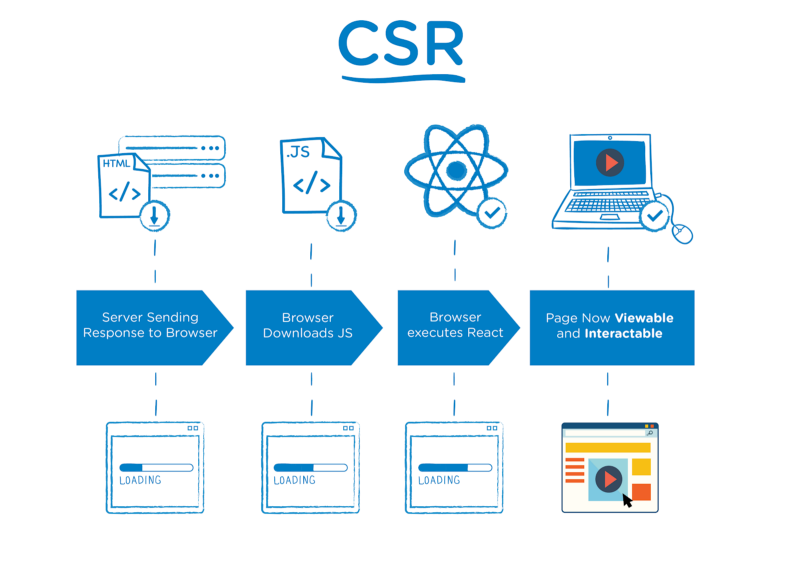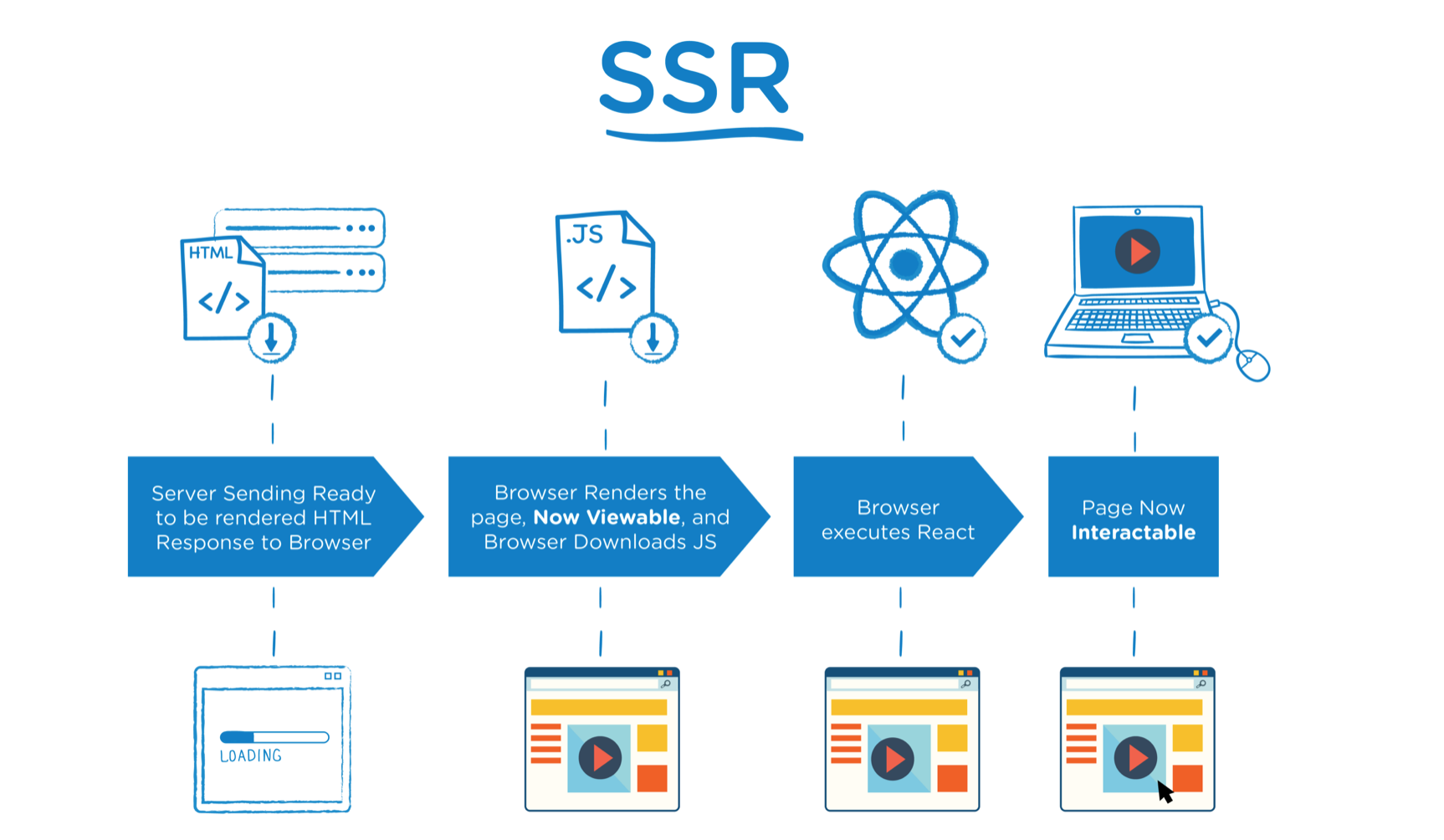- 8 min. read
Server vs Client Side Rendering (SSR vs CSR)
Webcomet
Software Company
In modern web development, rendering strategies play a pivotal role in determining the performance, user experience, and SEO of a website. Two common rendering approaches are Server-Side Rendering (SSR) and Client-Side Rendering (CSR). Each has its own strengths and weaknesses, and choosing between them can greatly impact how users interact with your site.
In this blog, we’ll explore both SSR and CSR, compare their advantages and disadvantages, and discuss when to use each approach.
What is Server-Side Rendering (SSR)?

Server-Side Rendering is the process of rendering a web page on the server before it is sent to the browser. When a user requests a page, the server generates the HTML content and sends it to the client, where the page is displayed. This allows users to see the content immediately without having to wait for JavaScript to be downloaded and executed.
How Does SSR Work?
- Initial Request: A user makes a request to the server (e.g., by entering a URL or clicking a link).
- Server Processing: The server processes the request, runs the necessary code to generate the HTML, and assembles the page content.
- Response: The server sends the pre-rendered HTML to the browser.
- Hydration: Once the HTML is loaded, JavaScript takes over and allows dynamic content to be updated, making the page interactive.
Advantages of SSR
- Faster Initial Load: Since the HTML is pre-rendered, users can see the page almost immediately, leading to faster perceived load times.
- SEO-Friendly: Search engines can easily crawl pre-rendered content, making SSR an excellent choice for SEO, especially for content-heavy websites.
- Consistent User Experience: SSR ensures that users receive the fully rendered page in the first request, offering a seamless experience across devices.
Disadvantages of SSR
- Slower Interactivity: Even though the initial page loads quickly, the page might not be interactive until JavaScript has been fully processed.
- Increased Server Load: Since the server is responsible for rendering the page, it can lead to higher resource consumption, particularly with a large number of users.
- Limited Interactivity: SSR might not be suitable for applications that require complex client-side interactivity and dynamic data updates.
What is Client-Side Rendering (CSR)?
Client-Side Rendering, on the other hand, involves rendering a page in the browser using JavaScript. Instead of pre-rendering HTML on the server, the browser loads a minimal HTML shell, which is then populated with content dynamically via JavaScript. This approach is often associated with Single-Page Applications (SPAs).
How Does CSR Work?
- Initial Request: A user makes a request to the server, which serves a basic HTML template along with JavaScript files.
- Client-Side Processing: Once the JavaScript is loaded, it fetches the necessary data from APIs and renders the content in the browser.
- Dynamic Updates: As users interact with the application, JavaScript handles any further rendering and updates the UI without requiring a page reload.
Advantages of CSR
- Smooth User Experience: CSR offers a seamless, interactive user experience since the page does not need to be reloaded. Once the app is loaded, the client can handle all interactions.
- Reduced Server Load: The server only needs to serve static files (HTML, CSS, JS), as the client handles rendering and dynamic updates.
- Rich Interactivity: CSR is ideal for applications that require real-time updates, such as social media platforms, messaging apps, or dashboards.
Disadvantages of CSR
- Slower Initial Load: Since the browser needs to load and execute JavaScript to render the page, the initial load can be slower compared to SSR.
- SEO Challenges: Search engines have difficulty indexing content rendered exclusively on the client-side, which can negatively impact SEO, although tools like pre-rendering and server-side hydration can help.
- Higher Time to First Interaction: Users may have to wait for JavaScript to download and execute before they can interact with the page, which can increase time to first interaction.
SSR vs CSR: Key Differences
| Feature | SSR | CSR |
|---|---|---|
| Initial Load Time | Faster initial load with pre-rendered HTML | Slower initial load as JavaScript needs to execute |
| SEO | Excellent for SEO as content is available in the HTML | Requires additional strategies (e.g., pre-rendering) for SEO |
| Interactivity | Limited interactivity until JavaScript is loaded | Fast and dynamic interactivity once JavaScript is loaded |
| Server Load | High, since the server renders the page on each request | Low, as the server only serves static files |
| Best For | Content-heavy sites (e.g., blogs, news websites) | Highly interactive apps (e.g., social networks, dashboards) |
When to Use Server-Side Rendering

While SSR offers significant advantages in terms of SEO and initial load time, it is not always the best fit for every project. SSR is most effective in the following scenarios:
1. SEO-Critical Websites
Websites that rely on search engine rankings for traffic, such as blogs, news sites, or e-commerce platforms, benefit greatly from SSR. Since the content is fully rendered on the server, search engines can easily index the page.
2. Content-Heavy Pages
Websites with a lot of static content (like blogs or landing pages) are a great fit for SSR. The server can quickly serve the pre-rendered HTML, making the website more performant for the user.
3. First Contentful Paint (FCP) Optimization
If your goal is to make the page visible to the user as soon as possible, SSR is the way to go. Since the server sends the fully-rendered HTML, users can see the page almost instantly.
When to Use Client-Side Rendering
CSR is ideal for applications that require a high level of interactivity and dynamic content. Consider CSR in the following scenarios:
1. Single-Page Applications (SPAs)
If you are building a single-page app that relies heavily on client-side interactivity (e.g., dashboards, social media platforms, and messaging apps), CSR is likely the best choice.
2. Applications with Real-Time Updates
CSR shines in applications that require real-time updates, such as chat apps, live feeds, and other interactive experiences. Once the initial load is complete, CSR allows the app to handle updates without requiring a full page reload.
3. Reduced Server Load
For applications where the server has to handle a large number of requests, CSR helps offload the work to the client, keeping the server load to a minimum.